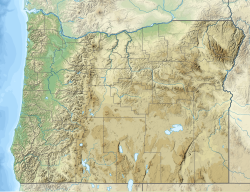| Warner Canyon | |
|---|---|
 Main run at Warner Canyon | |
Location in Oregon | |
| Location | Lake County, Oregon, US |
| Nearest major city | Lakeview 9 miles (14 km) west |
| Coordinates | 42°14′15″N120°17′45″W / 42.23749°N 120.29583°W |
| Top elevation | 6,683 feet (2,037 m) [1] |
| Base elevation | 5,683 feet (1,732 m) [1] |
| Skiable area | 300 acres (120 ha) [1] |
| Trails | 22 |
| Longest run | 1 mile (1.6 km) [1] |
| Lift system | 1 chairlift |
| Snowfall | 150 inches (3,800 mm) [1] |
| Website | https://www.warnercanyonski.com/ |
Warner Canyon is a small ski area in the U.S. state of Oregon. It is located in the Warner Mountains of south-central Oregon. Operating since 1938, [1] the ski area was once within the Fremont National Forest, but the land is now owned by Lake County; a land swap was completed between the USFS and Lake County in 1998. [2]
It is located 4 miles (6.4 km) northeast of Lakeview, a driving distance of 9.4 miles (15.1 km). There is one triple chairlift serving the hill, with two landings. [1] The total vertical drop is 780 feet (240 m). [1] The area is operated by a local non-profit, the Fremont Highlanders Ski Club. [3]

